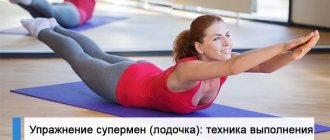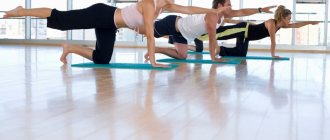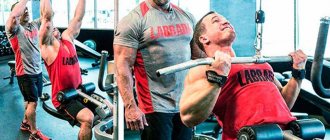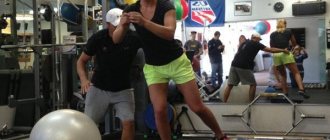What are the dangers of sedentary work?
First of all, sedentary work disrupts the blood supply to tissues and blood vessels due to a posture that impairs blood flow and disrupts the functions of organs and systems. Such a sedentary lifestyle leads to diseases, dysfunctions of the pelvic organs, and worsens sexual function.
Secondary reasons, but no less harmful, are poor posture and muscle atony. Some muscles are in hypertonicity, for example, the trapezius, which worsens not only posture, but also the blood supply to the vessels of the head, since the vessels in the neck are pinched by an overstrained muscle. Therefore, it is important to promptly relieve tension from overloaded muscles and tone relaxed ones.
How to sit correctly at work?
There are several recommendations that will help reduce the risks and complications of sedentary work:
- You cannot throw your legs over each other - this impairs blood flow not only in the lower extremities, but also in the brain. It is necessary to keep them at right angles.
- Straight back and straightened shoulders. To ease the load on your back, you should lean back in your chair.
- The bend in the elbows should be straight; it is advisable to use a mat with a special support for the hand.
- The center of the monitor should be located slightly lower from the eyes. The optimal distance to the monitor is an outstretched arm.
A set of exercises for fitness in the office
Warm-up
Head tilts
An office worker's neck muscles suffer no less than their back, so to relax and warm them up, it is necessary to perform a number of exercises.
Standing straight, tilt your head towards your shoulder, but without raising your shoulder towards you. It is important not to bend as low as possible, but to gently stretch the neck muscles from the side. Then you need to change the inclination and alternate 10-15 times on each side.
Head turns
When turning, it is important to keep your chin in line. Also, do not force your head back. Perform turns without jerking, concentrate on the neck muscles. Perform 10-15 turns in each direction.
Circular movements
In this exercise, it is necessary to perform a semicircle without throwing your head back, as this can cause discomfort and pain. It is enough to perform a semicircle from shoulder to shoulder, stretching the back of the neck. A total of 10-15 turns in each direction.
Shoulder rotations
Perform circular movements with your shoulders back 15-20 times at maximum amplitude. Then repeat forward movements.
Hand rotations
Also perform circular movements with your arms at full amplitude, effectively stretching the muscles and working the joints. In one direction and the other - 10-15 repetitions.
Torso rotations
It is important to perform rotations exclusively in the thoracic spine. To do this, you need to tighten your abdominal muscles and fix your lower back. Place your feet hip-width apart, spread your arms to the sides at shoulder level. As you exhale, rotate to one side without moving your pelvis; while inhaling, return to the center. And once again, as you exhale, twist your torso in the other direction. And so 10-15 repetitions for each.
Torso bends
Raise one arm above your head and repeat 15 to 20 bends in one direction, then in the other. The bends should be quite energetic, but not sharp. When performing it, it is important not to move your pelvis to the side; bend only through your torso, and not your whole body.
Circular movements of the pelvis
The exercise warms up the hip joint and ligaments. Perform rotations in a full circle, that is, with a maximum amplitude, 10-15 times in each direction.
Half squats
Half-amplitude squats will help warm up the knee joints, minimally involving unheated leg muscles in the work. Squat without bringing your thighs parallel to the floor. Raise your arms in front of you as you bend your knees. Place your body weight on your heels. Perform 15-20 repetitions.
Knee extension
While standing, raise your thigh parallel to the floor and extend your knee 10-15 times, maintaining balance. Repeat on the other leg. This exercise will warm up your knee joints and quadriceps.
Calf raises
Shift your body weight from your toes to your heels. The exercise will help not only warm up the ankle joints, but also the muscles of the lower leg. 10-15 times.
Circular movements of the foot
Rotate each foot in one direction and the other 10-15 times.
Set of exercises
Squats
Perform squats until they are parallel to the floor, if office clothes allow. The main goal is to work the gluteal muscles and hips, which are the foundation for a healthy spine. Perform the approach until you feel a burning sensation in the muscles. With bodyweight, 30-50 repetitions may be sufficient.
Forward bends
This exercise will stretch and relax tight muscles in the back of the body, while strengthening the lower back and buttocks. Place your hands on your waist and bend over with straight knees without rounding your back. The main goal is to stretch the back of the thighs, and not bend as low as possible. Perform 20-40 inclines.
Swing your legs to the sides
During the exercise, you can use the back of a chair for support or maintain balance yourself. Move your leg to the side not with a sharp swing, but with the strength of your thigh and buttock muscles. As you exhale, lift your legs a little faster and lower them down slowly. Perform 15-20 swings on each leg. The more concentrated the swings are, the more difficult they are to perform.
Swing back
This option strengthens the gluteal muscles. The main thing is not to bend your lower back when abducting your leg. Grasp the back of a chair or the edge of a table with your hands. Bend your torso forward and lift the foot of your working leg off the floor. As you exhale, move your leg back using your buttocks. Do not make sudden swings or raise your leg too high, arching your lower back. For each leg – 15-20 repetitions.
Table push-ups
This is a general strengthening exercise not only for the pectoral muscles and triceps, but also for training all muscles at the same time, since the muscles of the back, abdomen, thighs and buttocks are also involved in the work. To perform the technique, place your hands on the edge of the table, spaced wide apart. As you inhale, bend your elbows, aiming your chest as low as possible towards the table. Exhale as you straighten your elbows. Do push-ups to the maximum, that is, perform the maximum number of repetitions before the onset of muscle fatigue.
Static force for chest
Place your palms together in the center of your chest. Your forearms should be parallel to the floor. As you exhale, press one palm onto the other with maximum effort without holding your breath. Hold the tension for 30 to 60 seconds. The exercise loads the chest and shoulder girdle.
Reverse chair push-ups
The exercise strengthens the shoulder girdle, including the triceps, as well as the pectoral muscles. To perform this, you need to place your hands behind your back on the edge of a chair, shoulder-width apart, and straighten your knees. As you inhale, bend your elbows to 90 degrees, lowering your pelvis to the floor, and as you exhale, straighten your arms. Repeat as many times as possible until muscle failure occurs.
Crease on a chair
An abdominal exercise that is performed while sitting on a chair. To do this, you need to turn sideways to the back of the chair so that it does not interfere with movement. Round your back, leaning back slightly. Tighten your abdominal muscles and lift your bent knees toward your chest. You can hold onto a chair with your hands or hold it on your chest. As you inhale, lean back without straightening your back, and at the same time straighten your knees, stretching your legs forward. As you exhale, use your abs to fold back. Do 15-25 repetitions this way.
Stretching
Back rounding + arching
While standing, clasp your hands in front of you, with your palms facing away from you. As you exhale, round your back, stretching the muscles along the spine, and as you inhale, place your hands behind your head over the top, forming a slight deflection exclusively in the thoracic region. Perform dynamic stretches at a relaxed pace.
Chest traction
Raise your arms to shoulder level and move them to the sides. Using springy movements, smoothly move your arms back, stretching the pectoral muscles.
You can also add a lock behind your back and squeeze your shoulder blades together, opening your chest, feeling a stretch in the thoracic region.
Triceps extension behind the head
Raise your arm above your head and bend it at the elbow. With your other hand, grab your elbow and apply slight pressure. It is important to feel the stretch on the back of your arm. Repeat on the other hand.
Heel to buttocks
While standing, hold your foot with one hand, pulling your heel toward your buttocks. Keep your knees together. Feel the stretch on the front of your thigh. Repeat on the other leg.
Tilt to straight legs
Perform the fold while standing, stretching the entire back of your body, including your spine. Using your hands, you can increase the traction by bringing your stomach closer to your hips.
What is industrial gymnastics: how it all began in the USSR
It cannot be said that this kind of physical education appeared purely for political reasons; that would be erroneous and incorrect. The very trend of a total increase in the “titans” of mental labor working in offices has led to the need to introduce at least five-minute grades into their ranks. Industrial gymnastics has never become a relic of the past, because there is absolutely no doubt about its benefits. After all, muscle activity is a biological, vital need of the body.
To answer all the questions at once, let's give a brief definition of industrial gymnastics as a type of physical education, like workout or exotic dance. This is a mini-set of exercises that can and should be performed during the work process to quickly relieve fatigue, tension, muscle and nerve tension.
Brief history
Few people know that back in the early thirties of the twentieth century in the Soviet Union they began to think about the dangers of a sedentary, sedentary lifestyle. The Communist Party decided to take care of office workers, who grew in number every year. Enormous research work was carried out. Scientists were able to find out that the labor productivity of those people who were fond of five-minute sports became much higher compared to others.
The All-Union Scientific and Practical Conference on the Problems of Physical Culture and Active Longevity became the final evaluative factor. It became clear that the importance of physical education is very broad, even on a national scale. Gymnastics began to be introduced everywhere. As experiments have shown, after its implementation, labor productivity significantly increased, but various health complaints, for example, pain in the joints and spine, became less common.
Special complexes of such gymnastics were not compiled by chance, but based on the specifics of the production itself. For example, at a sewing factory, where mostly women work, the type of work is sedentary. Therefore, the complex included exercises for those muscle groups that are not used by a seamstress. However, at a bakery plant, workers spend almost the entire shift on their feet. Therefore, movements have been developed for them that are performed mainly while sitting. If you add self-massage of the feet to them, then the picture becomes complete. This proves that it makes sense to select exercises that best suit your lifestyle, work, and type of mobility.
The purpose and objectives of industrial gymnastics
Every responsible employer cares about the health of its employees, and on top of that, there are already clearly developed regulations governing all aspects of ensuring good working conditions. Violations of rules and regulations can be punished both administratively and criminally. It is logical to include a special set of health-improving exercises in the list of necessary conditions. Thanks to them, any employee can not only significantly increase their productivity, but also improve their health.
- Correctly, and most importantly, done on time, gymnastics helps to significantly strengthen the immune system, as well as improve performance.
- Gymnastics prepares the body for new achievements and maintains performance throughout the day.
- Gymnastics should prepare a person for a certain type of activity, which is clearly seen in the example of a seamstress and a bakery employee described above.
- Preventive measures to prevent the negative impact of various environmental factors.
To minimize fatigue at work, as well as after it, it is enough to perform just a small, five or ten-minute set of exercises that are quite simple and accessible to everyone. This does not require any special devices, so they can be done in absolutely any environment, from an industrial workshop of any production to an ordinary office.
Benefits of doing gymnastics in the workplace
We have already figured out why such gymnastics is needed, it remains to find out what advantages it offers.
- Even a few well-chosen exercises will be enough to increase an employee’s performance and maintain it throughout the day.
- Exercising without interruption from work will tone your muscles, warm up your joints and ligaments, thereby maintaining their mobility.
- Office work often involves a lot of stress, and knowledge workers are prone to frequent depression. Exercise will help you quickly level out your emotional background, bring yourself to your senses, and get rid of stress.
To maximize the effect of industrial gymnastics, it doesn’t hurt to pause to do the exercises at least 2-3 times a day. Typically one session takes from three to twelve minutes. It will really help you cheer up and restore your performance.
Forms and types of industrial gymnastics
The types of this kind of physical education have been formed depending on numerous factors that must be taken into account. The different forms of industrial gymnastics are as follows.
Introductory lesson
Not everyone is able to get up in the morning and quickly finish their daily chores and immediately get to work. However, this must be done, and the sooner you turn on, the better. Precisely in order to get into the process faster and better, gymnastics was invented before work. Simple exercises will help any person achieve optimal functioning of the nervous system and give it an optimal working rhythm.
For the right effect, it is important to choose the right exercises. Just 5-8 movements in five minutes are enough to achieve the desired result. It's best when all employees do them together, this will make the gymnastics more fun, and the colleagues themselves will be more united around common tasks.
Pause before lunch
The second form of industrial gymnastics is a short pause, approximately chosen for the second half of the working day. It is best to set the time two to three hours later than lunch, so that all the food has already been successfully digested by then.
This activity invigorates, relieves signs of fatigue, clears the head, promotes concentration and concentration. Exercises are selected depending on the activity. If you have no experience in this matter, you can find a trainer who will be happy to advise you. Usually the complex includes about 6-8 simple exercises.
Five minutes of physical education
The name does not reflect the whole essence of such charging, because it usually takes no more than a couple of minutes. For a lesson, only 2-3 exercises are enough, not distinguished by a high level of complexity or load. It is intended to relieve local fatigue, for example, when a person remains in the same position for a long time. There is usually not much time allotted for it, and you can perform the exercises up to five to six times a day, as soon as fatigue begins to make itself felt.
For which workers is it suitable: classification by occupational groups
The number of workers employed in offices is increasing every year. First of all, physical education is needed by the so-called “white collar” workers, that is, those who work mentally.
- Bank employees.
- Copywriters.
- Translators.
- Secretaries.
- Programmers.
- Engineers.
- Accountants.
Even now they have already turned into a countless army. The main problem they all face is pain in the joints and back. Osteochondrosis, constant pain in the cervical spine, obesity, physical inactivity, hemorrhoids - these are just a few of the possible diseases that can be avoided if you respond to emerging symptoms in time and take action.
Features of industrial gymnastics depending on labor groups
The organization of such classes requires the identification of main subgroups of workers. Each such group requires special exercises during the working day.
First
This subgroup includes everyone who is exposed to the greatest stress in the workplace and constantly experiences stress. Often their work is the same type, monotonous, boring. Therefore, it especially requires attentiveness, concentration, and often also acute vision.
- Seamstresses.
- Workers at machines, including robotic ones.
- Shoe production workers.
- Assemblers of small mechanisms.
This also includes radio technicians in large industries, adjusters of small equipment, and similar professions.
Second
This group includes those employees whose work combines mental work with little physical activity.
- Pickers.
- Turners.
- Packers.
- Milling workers.
As a rule, to perform work, such people need not only to think, but also to do something. Great physical activity is not expected.
Third
The third subgroup includes those professions that involve more serious physical activity. Moreover, you shouldn’t think that they don’t need industrial gymnastics, since they already work hard.
- Builders of different specializations.
- Various types of molders.
- Steelworkers.
- Miners.
- Locksmiths and other working specialties.
Such workers will require special exercises aimed at developing endurance and the body’s resistance to stress.
Fourth
The last group includes only employees of purely mental work.
- Scientists.
- Teachers.
- Medical workers.
- Engineers.
Many people literally work their butts off, including their internal “robot mode.” However, there is nothing good about this. As a result, after many years of such exhausting work, a person may experience cardiovascular problems, vision deterioration, and pain in the back and joints. To avoid such sad consequences, without saying goodbye to your favorite job, it doesn’t hurt to take care of yourself, and at the same time familiarize yourself with the basics of physical education.
sitting pigeon
Problem: After a long meeting, your legs are numb and your knees are tired. To correct these unpleasant sensations, you can do the “pigeon” exercise. It stretches the muscles of the hips and back. But the main thing is not to overdo it; during the exercise you should feel relief, not new pain.
What to do: Sit up straight. Bend one leg at the knee and place your ankle on the thigh of the other leg (near the knee). Stretch your body forward, opening your chest and trying to reach your stomach with your thigh. Make sure that your spine is stretched upward and your back is straight. Perform the exercise for 5 breaths. Repeat with the other leg.
Tilts to the side
Problem: if you sit in one place for a long time and begin to experience discomfort, you can try bending from side to side. This exercise helps to stretch the muscles on one side while the muscles on the other side contract. This exercise also works the chest and arms. Thanks to bending, you can quickly restore muscle tone and restore breathing.
What to do: sit upright, grab the seat of the chair with one hand, relax your shoulder and let it fall down. Raise your other arm up, then lean towards the lowered arm, strictly to the side, without tilting your spine forward or backward. Then do the same with the other hand, repeat 5-10 times.
Gymnastics for the eyes when working at the computer
In order to avoid computer eye pain, it is important to follow three standard rules :
- Take a mandatory break between work (it is advisable to free up time for rest every 30 minutes).
- Do complex eye exercises using any chosen method.
- Adjust your monitor to create optimal screen brightness. The contrast also needs to be adjusted so that the eyes are as comfortable as possible.
As for the special warm-up for the eyes, it must be repeated as often as possible. The simplest exercise is the following: look into the distance, fix your gaze on some distant object, and then look sharply at a nearby object and also hold your gaze. This will help relieve intense stress and significantly relieve tension in the eye muscles.
Systematic implementation of eye exercises when working at a computer will help to avoid such occupational diseases of computer scientists as myopia and significant weakening of vision. Eye training must be done regularly - during rest breaks it is important not to forget about eye exercises, but here it is important to maintain moderation. A short series of 5 exercises will be enough:
- You need to close your eyes tightly for about 3 seconds, then open them and not blink for 3 seconds. The exercise must be repeated 5 times.
- Rapid blinking for 1 minute.
- It is necessary to close your eyes and perform a kind of massage of the eyelids - for 30 seconds you need to massage the eyelids in a circular motion clockwise with your index fingers.
- Consistently alternate looking at close and distant objects.
- In conclusion, be sure to repeat the eyelid massage with your index fingers.
If there is no time for exercise, a very short warm-up will help . It is necessary to close your eyes and make a rotational movement with your eyes several times in one direction and the other.











